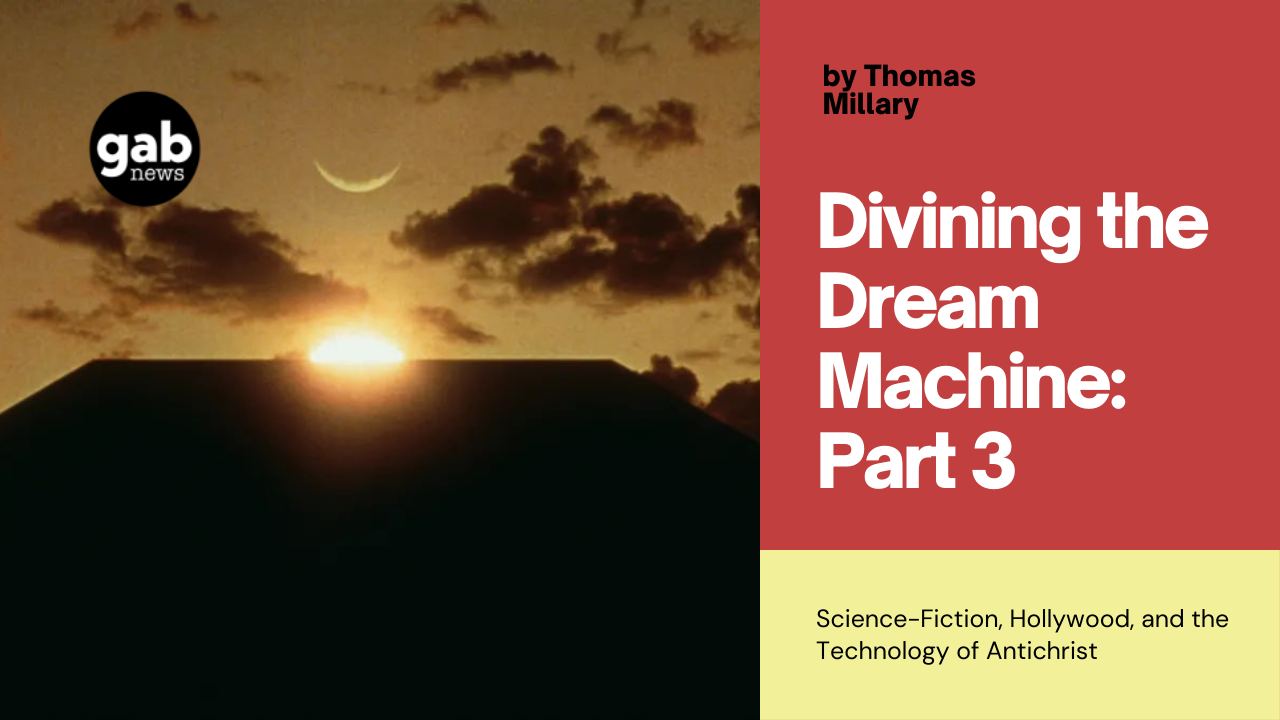Science-Fiction, Hollywood, and the Technology of Antichrist
by Thomas Millary
Weston’s Evolving Worldview
The worldview of sci-fi has spilled out from fiction into pop-intellectualism from the beginning. Father of the genre HG Wells was also a social critic, whose books such as The Open Conspiracy and The New World Order provided extensive arguments for a Fabian socialist ideal of global government, in which traditional religion and nation states are done away with and humanity is brought under the control of a benevolent scientific elite (whose rule would include population control).1 Such techno-utopianism is simply the flipside of the cosmic meaninglessness portrayed in Wells’ science-fiction literature, both indicating the displacing of God by the evolutionary process. The spirit of Wells is alive and well in contemporary figures such as Yuval Noah Harari, bestselling author of books such as Sapiens and Homo Deus, and the World Economic Forum’s favored public intellectual.
This article originally appeared in-full as an essay published on The Ludwell Review on November 8th, 2023. It is reproduced here, in three parts, with permission from the author.
Read Part 1 here.
Read Part 2 here.
Harari has made a career of confident pronouncements of the obsolescence of traditional views of humanity. “We humans should get used to the idea that we are no longer mysterious souls—we are now hackable animals.”2 He also believes that “In the early twenty-first century, perhaps the most important artistic genre is science fiction.”3 Harari hopes that scientists can use the genre to influence public perception to an even greater degree, especially in overcoming the idea of a stable human self. Perhaps we can trace the confluence of science-fiction and technocratic globalist ideology all the way back to Machine prophet Francis Bacon, as his utopian novel New Atlantis is considered by some to be the first real work of science-fiction.4 Of the political tradition of the World Economic Forum and its predecessors, Russian philosopher Alexander Dugin has perceptively written – “The power of the globalists, after all, is based on insinuations and ‘black miracles.’ They rule not on the basis of real power, but on illusions, simulacra, and artificial images, which they maniacally try to instill in the minds of mankind.”5
The scientistic fictions of megalomaniacal technocrats may ultimately be sold to the public largely through the spiritual iterations of these same narratives. A key passage from CS Lewis’s novel Perelandra, the second installment in his Ransom trilogy, illustrates this point.6 Lewis’ trilogy is not so much a Christian version of science-fiction as it is a rebuttal of the very premises of the genre, depicting a cosmos beyond earth that is not the infinite void of ‘outer space’ but rather “deep heaven,” saturated with God’s glory and untainted by Satan’s rebellion against the divine order. His first novel of the trilogy Out of the Silent Planet explicitly contrasts the grace-filled reality of what the protagonist Ransom finds on Mars with Wellsian expectations of cosmic terrors (“insect-like, vermiculate or crustacean Abominable…twitching feelers, — rasping wings, slimy coils, curling tentacles…monstrous union of superhuman intelligence and insatiable cruelty”).7 The antagonist Weston’s aspiration of humanity conquering the stars is implicitly associated with the godless sci-fi worldview that Lewis at times called “Wellsianity” (and a minor villain in the third installment of the trilogy, That Hideous Strength, is purposefully modeled on Wells).8 9
In Perelandra, Ransom encounters Weston a second time, but now Weston has followed his scientistic imperialism to its spiritually radical conclusions. He is no longer “fighting for Man against his non-human environment” but has given up any conception of separation between humanity and nature.10 His loyalty is now to “the Life-Force,” accepting divinity’s existence while equating it with a cosmic process of creative evolution.11 Lewis understood well that atheistic materialism is simply a cultural waiting room for demonic pantheism. Perelandra was published 25 years before 2001: A Space Odyssey but largely anticipates its worldview and refutes it in advance.
The panpsychist pantheist cosmic evolutionary sci-fi worldview found other popular expression in the psychedelically-influenced spirituality of the 1960s and its countercultural successors of later decades. Terence McKenna, pop-spirituality’s primary proponent of psilocybin mushrooms, was influenced by both the Western occult tradition and the sci-fi narratives of Clarke and Kubrick. He compared psychedelics to the monolith, seeing them as tools of techno-magical higher intelligences calling us into a blissful future.12 McKenna declared that we will “[dream] awake at the end of time” and he expected virtual reality technology to enable such dreaming.13 14 Timothy Leary, the acid-prophet of the 1960s, held the same enthusiasm for VR, eventually modifying his original slogan of “turn on, tune in, drop out” into “turn on, boot up, jack in,” after deciding that personal computers have essentially the same effect on humanity as LSD.15 Leary also wrote that “Higher Intelligence…has already sent a message to this planet. The U.F.O. message is in the form of the DNA code.”16 More of the same sci-fi story, the same techno-sorcerous evolutionary delusions. The so-called counterculture allows those who wish to see themselves as anti-establishment to enthusiastically partake in the Machine religion and its dissociative dreams of artificial immortality. The psychedelic experience itself is more infantilization disguised as divinizing enlightenment, no different from the consumer glued to the screen from which they stream the latest Disney show, or the hero of 2001 becoming a baby floating in a bright space-bubble.
Clarke, Kubrick, McKenna, and Leary all correspond to second-phase Weston, the secularist who has found the technology-driven spiritual narrative by which they may justify the re-introduction of occult concepts of apotheosis. The tech-deification story has even been given a Christian presentation, through the influential work of Jesuit priest Teilhard de Chardin, who made spiritualized evolution rather than Christ the center of the “new religion…an improved Christianity” that he hoped to establish.17 Even more so than the beliefs of the aforementioned figures, Weston’s conviction that creative evolution is a spiritual process with the goal of “a final vortex of self-thinking, self-originating activity” nearly perfectly predicts the concept that Teilhard called “the Omega Point”18 19 (which Terence McKenna took direct inspiration from, admiringly recognizing that Teilhard was “crafty enough in his Jesuitical way” to use Christian language to popularize radical ideas no different than his own psychedelic eschatology).20 When Lewis eventually read Teilhard’s The Phenomenon of Man, published over a decade after Perelandra, he called it “a radically bad book” and “pantheistic-biolatrous waffle.”21
Teilhard’s concept of the emerging “noosphere” describes “a planetary neo-envelope,” the biosphere linked with “an autonomous circulatory, nervous, and finally, cerebral system.”22 A worldwide Dream Machine, another externalized matrix-womb, the worship of technological divinity, justified through fanciful accounts of natural processes. Whether through the veneration of computers, or drugs, or blasphemous appropriations of Christian theology, the Machine appeals to our compromised imagination to pull us into the vortex of its deceptions. While figures like Wells and Harari condition the public to believe that science proves the cosmos and humankind to be devoid of meaning, it is the occultic evolutionary narratives which prime humanity to view its disintegration into the Machine as a spiritual ecstasy, an ascent to godhood. Lewis’ novels should serve as a cautionary tale to the real-life would-be prophets of the Machine science-fiction religion – “what Pantheists falsely hoped of Heaven bad men really received in Hell. They were melted down into their Master…”23
“By Means of Cunning Artifice”
In Kingsnorth’s talk “The Coming Transhuman Future,” he asks a terrifying question. “The transhumanists tell us they’re building God. But what if they’re building (whether by accident or by design) His opponent?”24 In the same talk, he quotes St. Ignatius Brianchaninov, from the same writing that contains the warning about aerial signs of the Antichrist. “The antichrist will reveal before mankind by means of cunning artifice, as in a theatre, a show of astonishing miracles, unexplainable by contemporary science…” If the Man of Sin’s miracles are unexplainable by contemporary science, perhaps he will use them to promote a science of the future, a science indistinguishable from magic and (as the saint tells us) revealed to mankind as if in a theater.
The religion of the future/the Machine has historical roots that long precede Hollywood science-fiction filmmaking and it is already starting to leave the medium of film behind, gravitating toward technological diversions that are even more schizophrenic in character. Horsley draws on philosopher Brian Rotman to describe the low-intensity DID effects naturally induced by digital technology in general. “Our digital technology does not operate by the rules of ‘I,’ of individual linear thinking, but by those of ‘distributed bio-social phenomena,’…”25 Of the internet, Kingsnorth writes, “I think of the words we use to describe this interface… the web; the net. I think these are things designed to trap prey.”26 Yet I believe that glancing slightly backwards in the Satanic scheme, to a recent time when movies in particular represented the cutting edge of technological entertainment, can reveal the devilish fractal logic by which the black oozing technology of Antichrist creeps into the world. Its advance is propelled by an endless cycle of our corrupted imaginations conjuring increasingly deadly technologies and those deadly technologies conditioning our imaginations into greater states of corruption, a demonic feedback loop of delusional pride and false creativity.
The research and development arm of Disney is tellingly called “Imagineering,” a portmanteau that summarizes the dynamics of the Dream Machine. A global entertainment empire, which has spent a century (precisely one hundred years this fall) building a brand associated with both enchantment and futurism and now owns virtually every culturally relevant cinematic franchise, proudly advertising its goal of engineering our imaginations. The title of the Kingsnorth essay from which I just quoted is the ominous phrase “You Are Harvest.” Horsley’s diagnosis of the goal of the Hollywood superculture is almost identical – “shaping and directing the collective dreaming mind by harvesting the energy of our rapt attentions. We are being farmed.”27 Our incessant deification of self has led us to bow down before the imagineering powers of the Dream Machine. All of this is building to the eventual emergence of an individual, the final Antichrist, the last celebrity, a man who will be in perfect sinister harmony with the Machine. As with any practice of devotion to celebrity, his followers taking his mark will be an act of worship directed toward both him and themselves.
While not every component of the religion of the Machine is reducible to science-fiction, at its foundation this religion is a science-fiction story, a delusion about technology that stretches back to the Tower of Babel (that hideous strength!), the lie that through technological innovation we can collapse the Creator/created distinction. Neither human imagination nor technology may be wholly irredeemable but the potential of digital technologies to manipulate our imaginations and fracture our sense of self may be the portal through which the infrastructure of hell is emerging onto the earth. Whether this will finally look like an advancement of VR (or AR) technology, or literal pods in which we must live where we will be given bugs to eat, or some yet unforeseen technological abomination, the Machine will promise the false wonder of permanent gratification, encasing us in bubbles of dull and sinful ecstasy for demons to feed upon. Thinking one more time to 2001, the tech-spirits being conjured look less like HAL-9000 trying to kill Bowman and more like the unseen entities’ successful transformation of Bowman into the ‘Star Child.’ It is a Machine not meant to annihilate us or even to replace us but rather to engulf us, to put every human that it can into a permanent state of tortured debasement, where the image of God within us can be maximally defiled and every passion that has haunted mankind since the fall can be automated and amplified.28
Those who become the bricks of the new Babel – simultaneously the Machine’s constructors, batteries, and products – will experience what Terence McKenna called “dreaming awake at the end time” and find it to be a waking nightmare before the end of the age. We cannot know how close we are to that true ending, but we can recognize the infernal machinery of Antichrist when we see it, the matrix-womb of the Whore of Babylon. I can end only by first circling back to the wisdom of Seraphim Rose and then turning to scripture itself. From Father Seraphim – “It is later than you think! Hasten, therefore, to do the work of God.”29 And Revelation 18:4 – “And I heard another voice from heaven saying, ‘Come out of her, my people, lest you share in her sins, and lest you receive of her plagues.’

Thomas Millary is the president of the Decoding Culture Foundation, a non-profit organization which analyzes cultural engineering and documents the history of collaboration between the film industry and the United States government. He is also the cohost of Psyop Cinema, a podcast about the influence of mind control programs and the occult over pop-culture. Thomas has an academic background in religious studies, concentrating on American countercultural spiritualities and espionage history.
FOOTNOTES:
- HG Wells, The Open Conspiracy (1928), (The New World Order (1940).
- “Read Yuval Harari’s blistering warning to Davos in full,” World Economic Forum https://www.weforum.org/agenda/2020/01/yuval-hararis-warning-davos-speech-future-predications/
- Yuval Noah Harari, 21 Lessons for the 21st Century (2018).
- Brian Merchant, “The First Scientific Utopia Still Matters 400 Years Later” (2020). https://onezero.medium.com/the-first-scientific-utopia-still-matters-400-years-later-395d1bb3184a
- Alexander Dugin, “The Manifesto of Great Awakening. Against Great Reset.” https://katehon.com/en/article/manifesto-great-awakening-against-great-reset
- CS Lewis, Perelandra (1943).
- CS Lewis, Out of the Silent Planet (1938), 37.
- CS Lewis, That Hideous Strength (1945).
- Joe R. Christopher “C.S. Lewis on the Final Frontier: Science and the Supernatural in the Space Trilogy” Mythlore (2010).
- Lewis, Perelandra, 78.
- Ibid., 80.
- “Terence McKenna ~ Apes Shouting At The Monolith ~ May 1990” https://www.youtube.com/watch?v=8p_ei5LPIZI
- Terence Mckenna, “Dreaming Awake at the End of Time” (1998). https://www.organism.earth/library/document/dreaming-awake-at-the-end-of-time
- “The Future Is Virtual (Terence McKenna VR Documentary)” https://www.youtube.com/watch?v=CXEj666l-rs
- Psychedelics and Virtual Reality – “Turn On, Boot Up, And Jack In” https://chemical-collective.com/blog/psychedelics-and-virtual-reality-turn-on-boot-up-and-jack-in/
- Timothy Leary, Exo-Psychology: A Manual on The Use of the Nervous System According to the Instructions of the Manufacturers (1977).
- Matthew Ehret, “Pierre Teilhard de Chardin’s Transhumanism and the Cult of the Fourth Industrial Revolution” https://matthewehret.substack.com/p/pierre-teilhard-de-chardins-transhumanism
- Lewis, Perelandra, 79.
- Pierre Teilhard de Chardin, The Phenomenon of Man (1955).
- Terence Mckenna, “Permitting Smart People to Hope” (1994). https://www.organism.earth/library/document/permitting-smart-people-to-hope
- John G. West, “Darwin in the Dock: C.S. Lewis’s Doubts about the Creative Power of Natural Selection” (2013). https://evolutionnews.org/2013/11/darwin_in_the_d_2/
- Pierre Teilhard de Chardin, The Future of Man (1964).
- Lewis, Perelandra, 148.
- “”THE COMING TRANSHUMAN FUTURE” – Live Talk with Author Paul Kingsnorth” https://www.youtube.com/watch?v=ns3ICVVVWVs
- Jasun Horsley, The Kubrickon: The Cult of Kubrick, Attention Capture, and the Inception of AI (Aeon Books, 2022) 144-145.
- Kingsnorth, “You Are Harvest”. https://paulkingsnorth.substack.com/p/you-are-harvest
- Horsley, 16 Maps, 61.
- The horrifying artwork of the occult-inspired HR Giger is perhaps the best prediction we have of what such a fate would look like, in its sinister erotic depictions of human flesh blended with technology. https://www.hrgiger.com/
- Fr. Seraphim Rose, Fr. Seraphim Rose: His Life and Works (2003).





